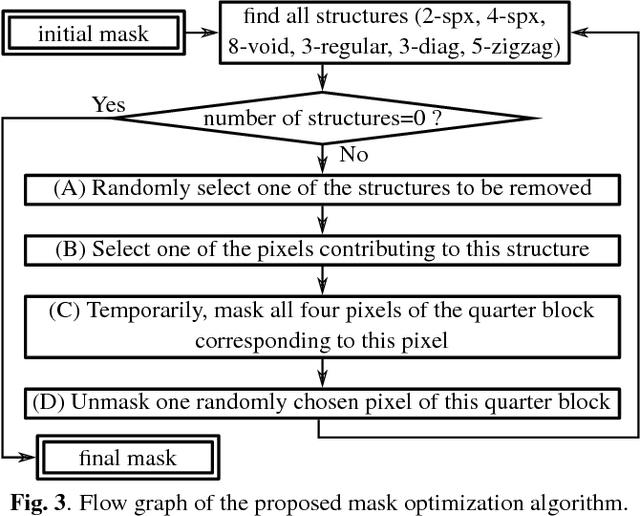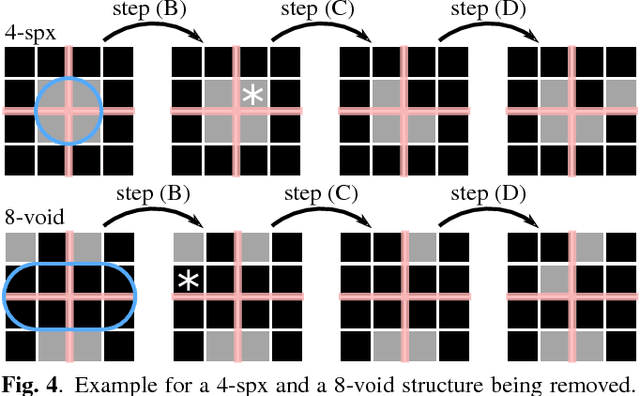Simon Grosche
Component-wise Power Estimation of Electrical Devices Using Thermal Imaging
Jul 18, 2023



Abstract:This paper presents a novel method to estimate the power consumption of distinct active components on an electronic carrier board by using thermal imaging. The components and the board can be made of heterogeneous material such as plastic, coated microchips, and metal bonds or wires, where a special coating for high emissivity is not required. The thermal images are recorded when the components on the board are dissipating power. In order to enable reliable estimates, a segmentation of the thermal image must be available that can be obtained by manual labeling, object detection methods, or exploiting layout information. Evaluations show that with low-resolution consumer infrared cameras and dissipated powers larger than 300mW, mean estimation errors of 10% can be achieved.
* 10 pages, 8 figures
Fast Reconstruction of Three-Quarter Sampling Measurements Using Recurrent Local Joint Sparse Deconvolution and Extrapolation
May 05, 2022


Abstract:Recently, non-regular three-quarter sampling has shown to deliver an increased image quality of image sensors by using differently oriented L-shaped pixels compared to the same number of square pixels. A three-quarter sampling sensor can be understood as a conventional low-resolution sensor where one quadrant of each square pixel is opaque. Subsequent to the measurement, the data can be reconstructed on a regular grid with twice the resolution in both spatial dimensions using an appropriate reconstruction algorithm. For this reconstruction, local joint sparse deconvolution and extrapolation (L-JSDE) has shown to perform very well. As a disadvantage, L-JSDE requires long computation times of several dozen minutes per megapixel. In this paper, we propose a faster version of L-JSDE called recurrent L-JSDE (RL-JSDE) which is a reformulation of L-JSDE. For reasonable recurrent measurement patterns, RL-JSDE provides significant speedups on both CPU and GPU without sacrificing image quality. Compared to L-JSDE, 20-fold and 733-fold speedups are achieved on CPU and GPU, respectively.
Novel Consistency Check For Fast Recursive Reconstruction Of Non-Regularly Sampled Video Data
Mar 17, 2022



Abstract:Quarter sampling is a novel sensor design that allows for an acquisition of higher resolution images without increasing the number of pixels. When being used for video data, one out of four pixels is measured in each frame. Effectively, this leads to a non-regular spatio-temporal sub-sampling. Compared to purely spatial or temporal sub-sampling, this allows for an increased reconstruction quality, as aliasing artifacts can be reduced. For the fast reconstruction of such sensor data with a fixed mask, recursive variant of frequency selective reconstruction (FSR) was proposed. Here, pixels measured in previous frames are projected into the current frame to support its reconstruction. In doing so, the motion between the frames is computed using template matching. Since some of the motion vectors may be erroneous, it is important to perform a proper consistency checking. In this paper, we propose faster consistency checking methods as well as a novel recursive FSR that uses the projected pixels different than in literature and can handle dynamic masks. Altogether, we are able to significantly increase the reconstruction quality by + 1.01 dB compared to the state-of-the-art recursive reconstruction method using a fixed mask. Compared to a single frame reconstruction, an average gain of about + 1.52 dB is achieved for dynamic masks. At the same time, the computational complexity of the consistency checks is reduced by a factor of 13 compared to the literature algorithm.
A Novel End-To-End Network for Reconstruction of Non-Regularly Sampled Image Data Using Locally Fully Connected Layers
Mar 17, 2022



Abstract:Quarter sampling and three-quarter sampling are novel sensor concepts that enable the acquisition of higher resolution images without increasing the number of pixels. This is achieved by non-regularly covering parts of each pixel of a low-resolution sensor such that only one quadrant or three quadrants of the sensor area of each pixel is sensitive to light. Combining a properly designed mask and a high-quality reconstruction algorithm, a higher image quality can be achieved than using a low-resolution sensor and subsequent upsampling. For the latter case, the image quality can be further enhanced using super resolution algorithms such as the very deep super resolution network (VDSR). In this paper, we propose a novel end-to-end neural network to reconstruct high resolution images from non-regularly sampled sensor data. The network is a concatenation of a locally fully connected reconstruction network (LFCR) and a standard VDSR network. Altogether, using a three-quarter sampling sensor with our novel neural network layout, the image quality in terms of PSNR for the Urban100 dataset can be increased by 2.96 dB compared to the state-of-the-art approach. Compared to a low-resolution sensor with VDSR, a gain of 1.11 dB is achieved.
Enhanced Image Reconstruction From Quarter Sampling Measurements Using An Adapted Very Deep Super Resolution Network
Mar 01, 2022



Abstract:Quarter sampling is a novel sensor concept that enables the acquisition of higher resolution images without increasing the number of pixels. This is achieved by covering three quarters of each pixel of a low-resolution sensor such that only one quadrant of the sensor area of each pixel is sensitive to light. By randomly masking different parts, effectively a non-regular sampling of a higher resolution image is performed. Combining a properly designed mask and a high-quality reconstruction algorithm, a higher image quality can be achieved than using a low-resolution sensor and subsequent upsampling. For the latter case, the image quality can be enhanced using super resolution algorithms. Recently, algorithms based on machine learning such as the Very Deep Super Resolution network (VDSR) proofed to be successful for this task. In this work, we transfer the concepts of VDSR to the special case of quarter sampling. Besides adapting the network layout to take advantage of the case of quarter sampling, we introduce a novel data augmentation technique enabled by quarter sampling. Altogether, using the quarter sampling sensor, the image quality in terms of PSNR can be increased by +0.67 dB for the Urban 100 dataset compared to using a low-resolution sensor with VDSR.
Design Techniques for Incremental Non-Regular Image Sampling Patterns
Mar 01, 2022



Abstract:Even though image signals are typically acquired on a regular two dimensional grid, there exist many scenarios where non-regular sampling is possible. Non-regular sampling can remove aliasing. In terms of the non-regular sampling patterns, there is a high degree of freedom in how to actually arrange the sampling positions. In literature, random patterns show higher reconstruction quality compared to regular patterns due to reduced aliasing effects. On the downside, random patterns feature large void areas which is also disadvantageous. In the scope of this work, we present two techniques to design optimized non-regular image sampling patterns for arbitrary sampling densities. Both techniques create incremental sampling patterns, i.e., one pixel position is added in each step until the desired sampling density is reached. Our proposed patterns increase the reconstruction quality by more than +0.5 dB in PSNR for a broad density range. Visual comparisons are provided.
Iterative Optimization of Quarter Sampling Masks for Non-Regular Sampling Sensors
Mar 01, 2022



Abstract:Non-regular sampling can reduce aliasing at the expense of noise. Recently, it has been shown that non-regular sampling can be carried out using a conventional regular imaging sensor when the surface of its individual pixels is partially covered. This technique is called quarter sampling (also 1/4 sampling), since only one quarter of each pixel is sensitive to light. For this purpose, the choice of a proper sampling mask is crucial to achieve a high reconstruction quality. In the scope of this work, we present an iterative algorithm to improve an arbitrary quarter sampling mask which results in a continuous increase of the reconstruction quality. In terms of the reconstruction algorithms, we test two simple algorithms, namely, linear interpolation and nearest neighbor interpolation, as well as two more sophisticated algorithms, namely, steering kernel regression and frequency selective extrapolation. Besides PSNR gains of +0.31 dB to +0.68 dB relative to a random quarter sampling mask resulting from our optimized mask, visually noticeable enhancements are perceptible.
Real-Time Frequency Selective Reconstruction through Register-Based Argmax Calculation
Feb 28, 2022



Abstract:Frequency Selective Reconstruction (FSR) is a state-of-the-art algorithm for solving diverse image reconstruction tasks, where a subset of pixel values in the image is missing. However, it entails a high computational complexity due to its iterative, blockwise procedure to reconstruct the missing pixel values. Although the complexity of FSR can be considerably decreased by performing its computations in the frequency domain, the reconstruction procedure still takes multiple seconds up to multiple minutes depending on the parameterization. However, FSR has the potential for a massive parallelization greatly improving its reconstruction time. In this paper, we introduce a novel highly parallelized formulation of FSR adapted to the capabilities of modern GPUs and propose a considerably accelerated calculation of the inherent argmax calculation. Altogether, we achieve a 100-fold speed-up, which enables the usage of FSR for real-time applications.
* 6 pages, 5 figures, Source code available at https://gitlab.lms.tf.fau.de/LMS/gpu-fsr
Image Super-Resolution Using T-Tetromino Pixels
Nov 17, 2021



Abstract:For modern high-resolution imaging sensors, pixel binning is performed in low-lighting conditions and in case high frame rates are required. To recover the original spatial resolution, single-image super-resolution techniques can be applied for upscaling. To achieve a higher image quality after upscaling, we propose a novel binning concept using tetromino-shaped pixels. In doing so, we investigate the reconstruction quality using tetromino pixels for the first time in literature. Instead of using different types of tetrominoes as proposed in the literature for a sensor layout, we show that using a small repeating cell consisting of only four T-tetrominoes is sufficient. For reconstruction, we use a locally fully connected reconstruction (LFCR) network as well as two classical reconstruction methods from the field of compressed sensing. Using the LFCR network in combination with the proposed tetromino layout, we achieve superior image quality in terms of PSNR, SSIM, and visually compared to conventional single-image super-resolution using the very deep super-resolution (VDSR) network. For the PSNR, a gain of up to +1.92 dB is achieved.
 Add to Chrome
Add to Chrome Add to Firefox
Add to Firefox Add to Edge
Add to Edge